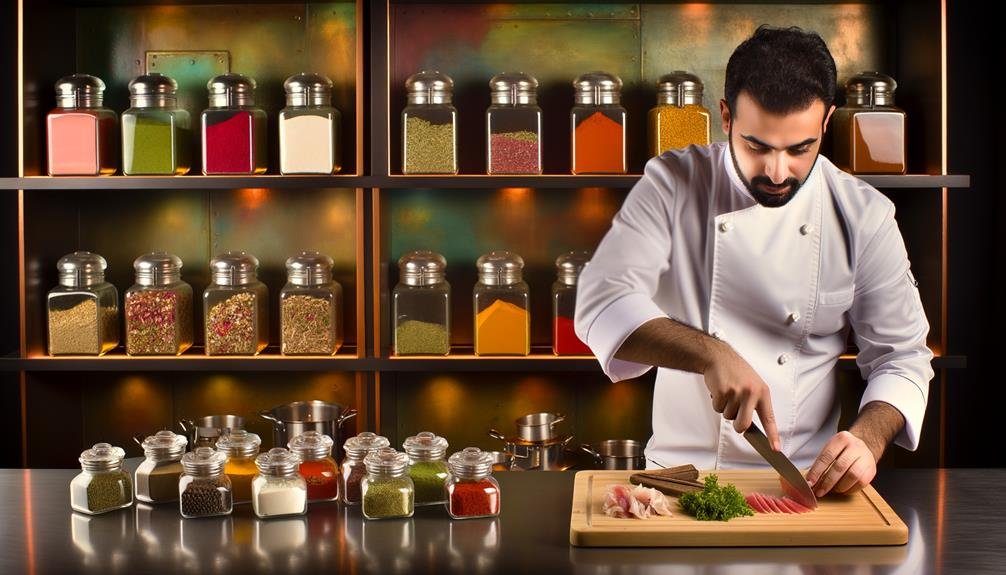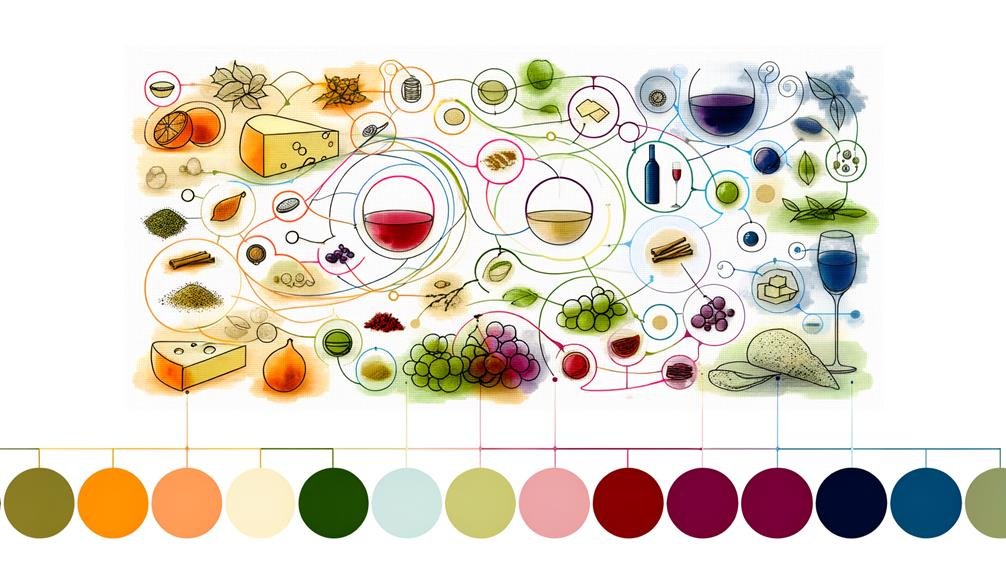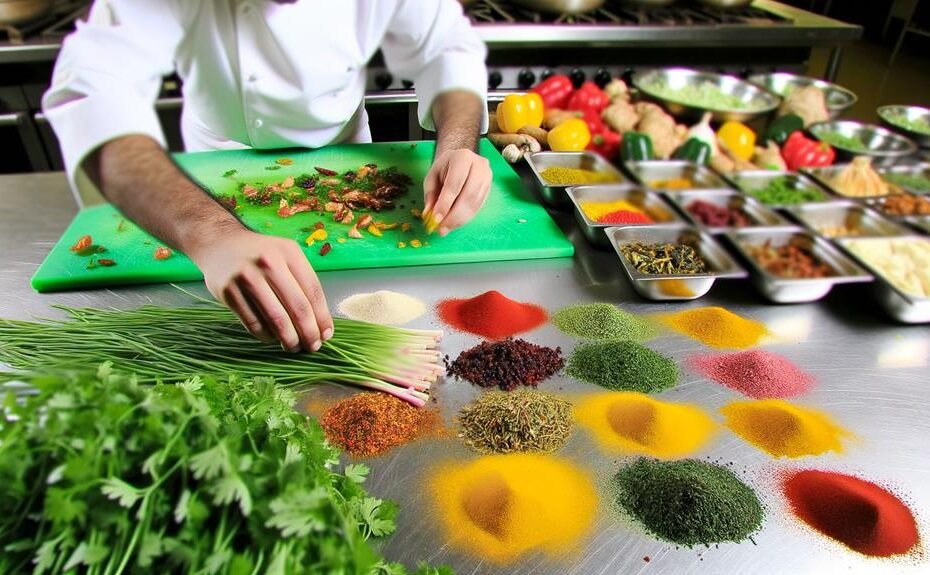Understanding the secrets of ideal flavor matches involves a deep dive into how taste, aroma, and texture come together to create exceptional culinary experiences.
By exploring the science behind taste perception and utilizing advanced flavor pairing techniques, chefs can unlock boundless creativity and sophistication in their dishes.
Tools like food pairing charts and diagrams empower chefs to experiment with unique ingredient combinations, leading to intriguing and unforgettable flavors.
The interconnected relationship between taste and smell opens doors to innovative culinary opportunities, prompting the question: how can these elements be skillfully harmonized to enhance culinary artistry?
Science of Taste Perception

The science of taste perception delves into how our taste buds and sense of smell work together to create the rich experience of flavor. Taste buds recognize primary tastes like sweet, salty, bitter, sour, umami, and fat, while our sense of smell picks up on volatile compounds that contribute to the aroma of food.
This collaboration between our taste and smell senses is crucial for discerning complex flavors. Modern studies in neurogastronomy shed light on how our brain processes these sensory inputs to form a unified flavor profile. This understanding empowers chefs to experiment with flavor combinations, elevating culinary experiences.
Innovative culinary techniques such as molecular gastronomy leverage these principles to craft surprising yet harmonious dishes that excite taste buds and awaken the senses.
Flavor Vs. Taste
To understand how we experience food, it's crucial to distinguish between flavor and taste. While often used interchangeably, they are actually distinct but interconnected concepts. Taste is limited to the basic sensations like sweet, salty, bitter, sour, umami, and fat, detected by the taste buds on the tongue.
On the other hand, flavor is a more comprehensive sensory experience that includes aroma and mouthfeel, created by chemical compounds in food.
When we talk about taste, we're mainly focusing on what our taste buds perceive. However, flavor goes beyond that by engaging our sense of smell, which adds depth to the culinary experience. Factors like temperature and texture also play a significant role in how we perceive flavor.
Our brain combines taste and aroma to give us the overall perception of flavor, making it a complex and intricate process. Additionally, intricate flavor profiles can either enhance or mask simple tastes, adding layers of complexity to our food experiences.
Understanding this interplay between flavor and taste is essential for chefs and food enthusiasts looking to create unique and innovative culinary delights. By paying attention to these nuances, one can elevate the dining experience and create dishes that tantalize the senses in unexpected ways.
Professional Flavor Pairing Techniques

To excel in professional flavor pairing techniques, chefs must grasp the science behind shared flavor compounds and how they interact in different food combinations. By understanding these interactions, culinary experts can create innovative and memorable dishes that tantalize the taste buds.
Platforms like Foodpairing.com are invaluable tools for chefs, as they analyze the molecular makeup of ingredients to unveil unexpected yet harmonious pairings. For example, the unlikely duo of strawberries and mushrooms share similar flavor compounds, leading to surprisingly delightful combinations.
Moreover, achieving a balance of the six fundamental tastes—sweet, salty, bitter, sour, umami, and fat—is crucial for enhancing the overall dining experience. This balance elevates cuisine to a new level, providing not just delicious meals but intellectually stimulating ones as well.
Wine and Food Pairing Tips
When it comes to pairing wine with food, it's essential to consider the flavors of the dish to enhance the overall dining experience. To create a successful pairing, keep these tips in mind:
- Matching weight: Light wines go well with delicate dishes, while fuller-bodied wines complement rich and flavorful dishes. For example, a light Pinot Grigio pairs beautifully with seafood, while a bold Cabernet Sauvignon enhances the flavors of a juicy steak.
- Complementing flavors: Look for wines that have similar flavor profiles to the dish you're serving. For instance, a citrusy Sauvignon Blanc can bring out the freshness in a lemony chicken piccata.
- Contrasting tastes: Use wine to balance out the dominant flavors in your dish. If you're serving a creamy pasta dish, a crisp and acidic Chardonnay can help cut through the richness.
- Consider sweetness: Opt for sweeter wines to pair with dishes that have sweet components. A Moscato or Riesling can be a delightful match for a dessert with fruity elements.
- Color coordination: Match the color of the wine with the type of meat you're serving. Red wine pairs well with red meats like beef or lamb, while white wine complements white meats such as chicken or fish.
Food Pairing Charts and Diagrams

Food pairing charts and diagrams are essential tools for chefs of all levels to create delicious and well-balanced dishes effortlessly. These visuals simplify the complex science of flavor combinations, making it easy to identify ingredients that work well together.
By showcasing shared flavor compounds, these charts empower chefs to explore new flavor pairings with confidence. For instance, a chart might recommend combining chocolate with blue cheese, a surprising yet successful match thanks to their shared flavor molecules.
Moreover, wine and food pairing diagrams help pair wines with dishes based on factors like sweetness and acidity, elevating the dining experience. Embracing these tools can elevate everyday meals into culinary delights, encouraging culinary creativity beyond traditional boundaries.
Conclusion
In conclusion, merging taste perception science with professional flavor pairing techniques opens up a world of culinary possibilities. By incorporating wine and food pairing expertise along with the strategic application of food pairing charts and diagrams, chefs can craft dishes that blend taste, aroma, and texture seamlessly. This harmonious blend of flavors, akin to a masterful orchestra performance, elevates dining experiences and fosters innovative culinary journeys that stimulate the mind.
By understanding the intricate nuances of flavor combinations, chefs can create unforgettable dishes that captivate the palate. For instance, pairing a rich and buttery Chardonnay with a creamy lobster risotto brings out the best in both the wine and the dish, enhancing the overall dining experience. This attention to detail and thoughtful pairing not only delights diners but also showcases the chef's skill and creativity in the kitchen.
In essence, the art of flavor pairing is a delicate dance between science and creativity, where each ingredient and element plays a crucial role in the overall symphony of flavors. Through thoughtful experimentation and a deep understanding of taste profiles, chefs can push the boundaries of traditional cuisine and create culinary masterpieces that leave a lasting impression on diners.
Embracing the secrets of ideal flavor matches is not just about creating delicious meals but also about embarking on a journey of culinary exploration and discovery.
